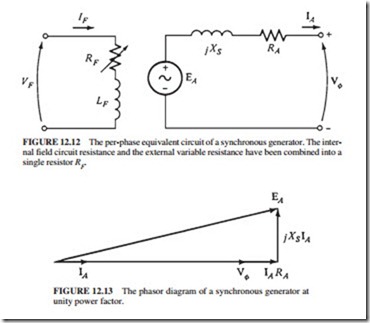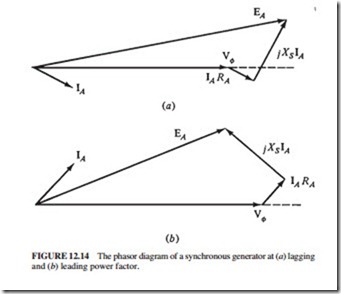 THE PHASOR DIAGRAM OF A SYNCHRONOUS GENERATOR
THE PHASOR DIAGRAM OF A SYNCHRONOUS GENERATOR
Phasors are used to describe the relationships between ac voltages. Figure 12.13 illustrates these relationships when the generator is supplying a purely resistive load (at unity power factor). The total voltage EA differs from the terminal voltage Vcp by the resistive and inductive voltage drops. All voltages and currents are referenced to Vcp, which is assumed arbitrarily to be at angle 0°.
Figure 12.14 illustrates the phasor diagrams of generators operating at lagging and leading power factors. Notice that for a given phase voltage and armature current, lagging loads require larger internal generated voltage EA than leading loads. Therefore, a larger field current is required for lagging loads to get the same terminal voltage, because
where w must remain constant to maintain constant frequency. Thus, for a given field current and magnitude of load current, the terminal voltage for lagging loads is lower than the one for leading loads.
In real synchronous generators, the winding resistance is much smaller than the synchro- nous reactance. Therefore, RA is often neglected in qualitative studies of voltage variations.
Related posts:
Incoming search terms:
- phasor diagram of synchronous generator
- phasor diagram of synchronous motor
- synchronous generator diagram
- phasor diagram of loaded alternator
- phasor diagram of a synchronous generator
- how to draw phasor diagram of synchronous generator
- phasor diagram of generator
- Vector Diagram for the Synchronous Generator
- phasor diagram synchronous generator
- total vector diagram of synchronous alternator
- phasor diagram generator
- phaisor duagram of synchronous generator for unity lagging leading
- The phasor diagram of synchronous generator with an inductive load
- Synchronous motor phasor diagram
- explain the phaser diagram of salient pole synchronous generator for the lagging power load
- Phasor reptesentation of power factor for inductive load for alternator
- generator supplying motor phasor diagram
- all phaser diagram of synchronous generator
- vector diagram of synchronous alternator
- phasor diagram of a 3 phase alternator under load conditions
- phasor of an over excited synchronous motor
- vector diagram of 3-phase synchronous generator
- leading power factor with phasor diagram in synchronous machine
- over-excited phasor diagram
- what is phosor diagram in synchronous motor
- general phasor diagram of over excited generator
- generator equivalent diagram
- leading pf diagram of alternator
- generator vector diagram
- leading load ka phase diagram
- leading lagging and unity power factor of alternator phser diagram
- how to draw phasor diagram of alternator under loded condition
- draw the phasor diagram of cylindrical rotot alternator in lagging pf and for syn motor in leading p f
- Diagram of a synchronous generator
- difference between phaser diagram of synchronous motor and alternator
- difference between phasor diagram of alternator and synchronous motor
- difference in phasor diagram for synchronous generator and motor
- draw a phaser diagram of over excited of synchronous motor
- draw and explain the equivalent circuit and phasor diagram of a cylindrical rotor alternator
- draw the diagram of an alternator lagging pf
- draw the equivalent curcuit and phasor diagram of a cylindrical rotor alternator fo lagging pf load
- draw the phase diagram of a synchronous generator at different power factor
- Draw the phaser diagram of a synchronous motor operating at overexcited and under excited conditions
- draw the phasor diagram of an alternator for following conditions (lagging p f leading p f unity p f)
- diagram of a three phase synchronous generator
- draw the phasor diagram of loaded alternator
- draw the pheser diagram of alternator at any load and pf lagging condition
- draw the vector diagram of loaded alternator when operated lagging and leading power factor
- drawing phasor diagram of generators
- drawing the phasor diagram for a synchronous generator

